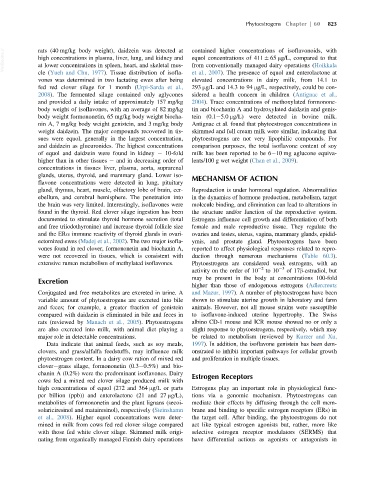Page 865 - Veterinary Toxicology, Basic and Clinical Principles, 3rd Edition
P. 865
Phytoestrogens Chapter | 60 823
VetBooks.ir rats (40 mg/kg body weight), daidzein was detected at contained higher concentrations of isoflavonoids, with
equol concentrations of 411 6 65 μg/L, compared to that
high concentrations in plasma, liver, lung, and kidney and
from conventionally managed dairy operations (Hoikkala
at lower concentrations in spleen, heart, and skeletal mus-
cle (Yueh and Chu, 1977). Tissue distribution of isofla- et al., 2007). The presence of equol and enterolactone at
vones was determined in two lactating ewes after being elevated concentrations in dairy milk, from 14.1 to
fed red clover silage for 1 month (Urpi-Sarda et al., 293 μg/L and 14.3 to 94 μg/L, respectively, could be con-
2008). The fermented silage contained only aglycones sidered a health concern in children (Antignac et al.,
and provided a daily intake of approximately 157 mg/kg 2004). Trace concentrations of methoxylated formonone-
body weight of isoflavones, with an average of 82 mg/kg tin and biochanin A and hydroxylated daidzein and genis-
body weight formononetin, 65 mg/kg body weight biocha- tein (0.1 5.0 μg/L) were detected in bovine milk.
nin A, 7 mg/kg body weight genistein, and 3 mg/kg body Antignac et al. found that phytoestrogen concentrations in
weight daidzein. The major compounds recovered in tis- skimmed and full cream milk were similar, indicating that
sues were equol, generally in the largest concentration, phytoestrogens are not very lipophilic compounds. For
and daidzein as glucuronides. The highest concentrations comparison purposes, the total isoflavone content of soy
of equol and daidzein were found in kidney 10-fold milk has been reported to be 6 10 mg aglucone equiva-
higher than in other tissues and in decreasing order of lents/100 g wet weight (Chan et al., 2009).
concentrations in tissues liver, plasma, aorta, suprarenal
glands, uterus, thyroid, and mammary gland. Lower iso- MECHANISM OF ACTION
flavone concentrations were detected in lung, pituitary
gland, thymus, heart, muscle, olfactory lobe of brain, cer- Reproduction is under hormonal regulation. Abnormalities
ebellum, and cerebral hemisphere. The penetration into in the dynamics of hormone production, metabolism, target
the brain was very limited. Interestingly, isoflavones were molecule binding, and elimination can lead to alterations in
found in the thyroid. Red clover silage ingestion has been the structure and/or function of the reproductive system.
documented to stimulate thyroid hormone secretion (total Estrogens influence cell growth and differentiation of both
and free triiodothyronine) and increase thyroid follicle size female and male reproductive tissue. They regulate the
and the ERα immune reactivity of thyroid glands in ovari- ovaries and testes, uterus, vagina, mammary glands, epidid-
ectomized ewes (Madej et al., 2002). The two major isofla- ymis, and prostate gland. Phytoestrogens have been
vones found in red clover, formononetin and biochanin A, reported to affect physiological responses related to repro-
were not recovered in tissues, which is consistent with duction through numerous mechanisms (Table 60.3).
extensive rumen metabolism of methylated isoflavones. Phytoestrogens are considered weak estrogens, with an
activity on the order of 10 2 to 10 3 of 17β-estradiol, but
may be present in the body at concentrations 100-fold
Excretion
higher than those of endogenous estrogens (Adlercreutz
Conjugated and free metabolites are excreted in urine. A and Mazur, 1997). A number of phytoestrogens have been
variable amount of phytoestrogens are excreted into bile shown to stimulate uterine growth in laboratory and farm
and feces; for example, a greater fraction of genistein animals. However, not all mouse strains were susceptible
compared with daidzein is eliminated in bile and feces in to isoflavone-induced uterine hypertrophy. The Swiss
rats (reviewed by Manach et al., 2005). Phytoestrogens albino CD-1 mouse and ICR mouse showed no or only a
are also excreted into milk, with animal diet playing a slight response to phytoestrogens, respectively, which may
major role in detectable concentrations. be related to metabolism (reviewed by Kurzer and Xu,
Data indicate that animal feeds, such as soy meals, 1997). In addition, the isoflavone genistein has been dem-
clovers, and grass/alfalfa feedstuffs, may influence milk onstrated to inhibit important pathways for cellular growth
phytoestrogen content. In a dairy cow ration of mixed red and proliferation in multiple tissues.
clover grass silage, formononetin (0.3 0.5%) and bio-
chanin A (0.2%) were the predominant isoflavones. Dairy Estrogen Receptors
cows fed a mixed red clover silage produced milk with
high concentrations of equol (272 and 364 μg/L or parts Estrogens play an important role in physiological func-
per billion (ppb)) and enterolactone (21 and 27 μg/L), tions via a genomic mechanism. Phytoestrogens can
metabolites of formononetin and the plant lignans (secoi- mediate their effects by diffusing through the cell mem-
solariciresinol and matairesinol), respectively (Steinshamn brane and binding to specific estrogen receptors (ERs) in
et al., 2008). Higher equol concentrations were deter- the target cell. After binding, the phytoestrogens do not
mined in milk from cows fed red clover silage compared act like typical estrogen agonists but, rather, more like
with those fed white clover silage. Skimmed milk origi- selective estrogen receptor modulators (SERMS) that
nating from organically managed Finnish dairy operations have differential actions as agonists or antagonists in

